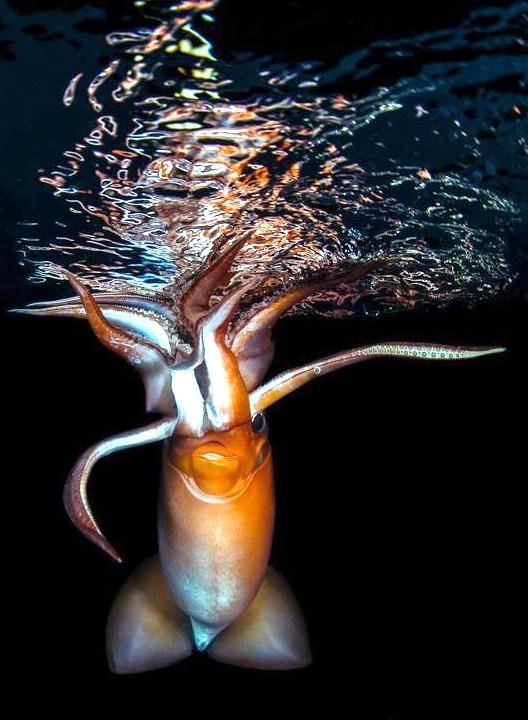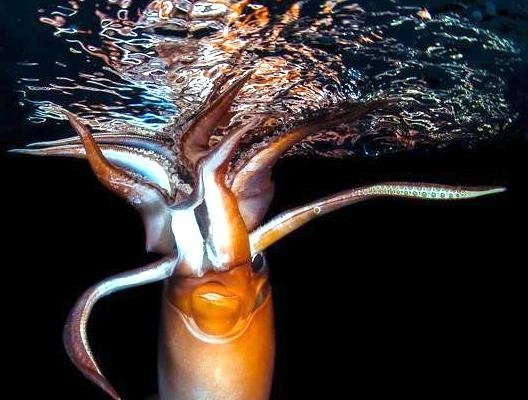
Imagine stumbling across an underwater world where these squids are the dominating force. They can change colors, hunt in groups, and even communicate through light. If you’re sipping your coffee and wondering how these intriguing beings work, sit back. I’m here to take you on a deep dive into the ten coolest facts about the Humboldt squid you probably didn’t know about.
1. Size Isn’t Everything
The Humboldt squid, or *Dosidicus gigas*, might be small compared to the giant squid, but these guys can pack a punch. They typically grow to about 6 feet long and weigh around 100 pounds. Still, what makes them impressive isn’t just their size, but their sheer agility. They can swim at speeds of up to 15 miles per hour, making them one of the fastest squids in the ocean. Now, that’s pretty fast for a creature that looks like it’s made of jelly!
Another cool aspect of their size is their tentacles. They have ten arms, which they use for hunting and grasping their prey. These are lined with sharp suckers that help them get a firm grip on slippery fish. The Humboldt squid’s size and strength make it a formidable predator in its ocean habitat.
2. Masters of Disguise
One of the most fascinating talents of the Humboldt squid is its ability to change colors. You might think of a chameleon when you hear this, but these squids take it a step further. They can shift their skin color from bright red to pale white, often using this ability to communicate with each other or to confuse their prey.
You’re probably wondering how they do this. The secret lies in special cells in their skin called chromatophores. These cells expand or contract to reveal different colors. It’s like having a built-in mood ring! For example, when feeling threatened, a Humboldt squid might turn a bright red to warn other squids or scare predators away. It’s almost like they’re throwing a colorful party under the sea!
3. Sharp Intelligence
Here’s the thing: Humboldt squids are known for their intelligence. If you’ve ever seen footage of them hunting, you might notice they work well together. They often hunt in groups, called schools, showcasing their cooperative behavior. This teamwork not only helps them catch prey more efficiently but also allows them to communicate using body language and color changes.
Research has shown that these squids have good memories, making them capable learners. For example, they can remember experiences and adapt their hunting strategies based on what they’ve encountered before. Just imagine them having a “team meeting” before heading out for dinner!
4. Unique Feeding Habits
What do Humboldt squids eat? Mostly, they feast on fish and other squids. Their hunting style is quite impressive. They use their speed and camouflage to surprise their prey. But here’s where it gets even cooler: they can also engage in a behavior known as “squid fishing.” This is when they lure fish closer before snatching them up with their tentacles.
You might be wondering how they catch so many fish at once. They actually have a unique way of swallowing their prey. After grabbing it, they pull it in and use a beak-like mouth to tear it apart. It’s like having their personal seafood buffet right there in the ocean!
5. Breathing Underwater
Like all squids, Humboldt squids breathe through gills. But their gills have a special adaptation that allows them to extract oxygen more efficiently from the water. When they swim, they draw water in through their bodies, allowing it to flow over their gills, where oxygen is absorbed. This quick breathing mechanism helps them stay agile and active, making them excellent hunters.
If you picture them zooming through the ocean, you can almost see the water flowing around them, filtering out oxygen to keep their energy levels up. This clever design is part of what makes them such efficient predators.
6. The Giant Predator
Speaking of predators, Humboldt squids have a reputation for being one of the ocean’s top predators. But here’s a fun twist: they have a natural enemy of their own! While they’re fierce and fast, they can also fall prey to larger marine animals, like sharks and orcas. This keeps the balance in their ecosystem, showing that even the mightiest have to watch their backs.
Interestingly, when Humboldt squids are at risk, they often display aggressive behavior, flashing bright colors and darting away. It’s a survival strategy that shows their instinctual understanding of danger.
7. Spawning Secrets
Humboldt squids have a unique way of reproducing. They typically spawn in deep waters, where the females release thousands of eggs. These eggs hatch into tiny squids, which are left to fend for themselves. Here’s the catch: once they reproduce, many Humboldt squids die shortly after. It’s an example of a “semelparity” lifestyle, meaning they invest everything into one big reproduction event.
This life cycle has a significant impact on their populations. While there are lots of eggs produced, the fact that many die after spawning means that only a few will survive to adulthood. It’s a fascinating, yet intense way to keep their species going.
8. Cultural Importance
Humboldt squids have made their mark not just scientifically, but culturally too. In many coastal regions of South America, they’re considered a delicacy, often appearing in traditional dishes. Their catch has become a significant economic activity for several fishing communities, showing just how intertwined they are with human life.
Moreover, these squids have become a symbol in various marine conservation discussions. Protecting their habitats means protecting other species as well, highlighting their role in the broader ocean ecosystem. It’s a reminder that every creature, big or small, has something valuable to contribute.
9. The Great Migration
Did you know that Humboldt squids are migratory? They travel thousands of miles in search of food and mates. These annual migrations can be quite impressive, involving large groups of squids moving together. It’s like an underwater parade!
This movement is influenced by water temperatures, currents, and the availability of prey. So if you ever hear about a “squid run,” it’s likely these fascinating creatures are on the move, demonstrating their resilience and adaptability in the changing ocean environment.
10. The Future of the Humboldt Squid
With climate change and overfishing impacting marine life, the future of the Humboldt squid faces challenges. Their populations are being affected by changes in water temperature and food availability, which can disrupt their breeding cycles. This brings attention to why conservation efforts matter.
By working to protect their habitats and manage fishing practices, we can help ensure that these incredible animals continue to thrive. It’s a call to action for all of us to pay attention to our oceans and the creatures that live within them.
In conclusion, the Humboldt squid is an amazing creature that goes beyond its surface-level appeal. From its intelligence and adaptability to its role in the ecosystem, there’s a lot to admire about these sea squids. So next time you think about these fascinating ocean dwellers, remember there’s a whole world of wonder beneath the waves!

